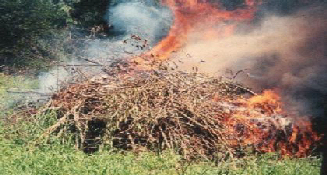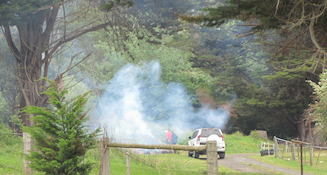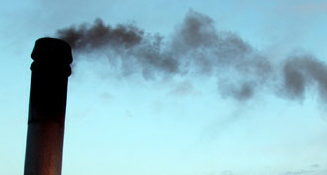Burning on Blocks under 2000 square meters, and
burning on blocks over 2000 square meters.
(See here for Wood heaters, fire places & incinerators.)
burning on blocks over 2000 square meters.
(See here for Wood heaters, fire places & incinerators.)
There are 29 councils in Tasmania. Details can be found here
The EPA says:
Councils are the correct people to be dealing with when it comes to back yard burning.
Councils in Tasmania are responsible for administering our environmental laws and regulations
in relation to smoke from wood heaters and back yard burning.
The EPA says individual councils can enact by-laws to restrict burning on blocks greater than
2000 square meters.
The EPA also state:
This does not mean fires can be lit with impunity.
There is no entitlement under legislation for any property owner or occupier of a property to
light fires and burn off vegetation waste and cause nuisance smoke
However, councils do not agree with what the EPA are sayings.
West Tamar Council says:
i) Councils have a responsibility for management of smoke issues on blocks less than 2000
square meters and the EPA has responsibility for those properties over 2000 square meters.
And,
ii) By-laws is not an area that councils can venture after receiving advice. This legal advice
closes the door on an avenue you were hopeful would bring you some relief.
iii) Based on previous discussions with councillors, I do not believe they are willing to support
(a by-law) at this time.
iv) One of the main reasons (for the under 2000 square meter regulation) is due to the
sensitivity of our Tamar valley airshed and it's air quality.
It is recognised that small scale smoke is a problem and yet much larger scale wood smoke
that pollutes the Tamar valley is allowed.
Further, the Local Government Association of Tasmania (LGAT), an organisation that supports
all councils, answered on their behalf in the Distributed Atmospheric Emissions Regulations
a) Councils generally do not have the resources to be proactive in this area.
b) Councils do not see it as their role to educate the public about regulations.
c) In relation to community public relations, councils are in an invidios situation while large
scale burn-offs continue.
d) Local Government does not generally consider backyard burning to be of high priority at
present.
Air Quality Policy
"The Local Government Association of Tasmania supports the development of a consistent and
balanced policy and regulatory response to the control of air quality in Tasmania."
"The Association acknowledges that Councils have responsibilities in relation to air quality."
On June 15, 2012 we met with the Minister for Environment Parks and Heritage (Hon. Brian
Wightman MP) to ask to have the above Council / EPA issues sorted out once and for all.
Despite our further enquiries, there has to-date been one unsatisfactory response from the
Minister. Wightman lost his seat in the 2014 State election.
Less smoke means cleaner air!
"Wood heater smoke contains fine particles and toxic chemicals including cancer causing compounds.
Any material floating about in the air can be breathed into our bodies. While some of the particles are exhaled, a fraction is retained and these can have adverse impacts on our health.
Most at risk are the young, the elderly or those people who sufferer from bronchitis, emphysema, asthma,
and other lung or heart diseases.
There is also evidence that fine particle matter can lead to premature deaths.
Especially at risk are elderly people who suffer from chronic respiratory problems.
Everybody has a responsibility to help keep our air clean. If you can see or smell smoke then you are
causing a problem for yourself, your family and your neighbours."
Even if you are healthy you can still be negatively affected by wood smoke causing you to feel lethargic and generally unwell.
- WA Department of Environment and Conservation
"Wood heater smoke contains fine particles and toxic chemicals including cancer causing compounds.
Any material floating about in the air can be breathed into our bodies. While some of the particles are exhaled, a fraction is retained and these can have adverse impacts on our health.
Most at risk are the young, the elderly or those people who sufferer from bronchitis, emphysema, asthma,
and other lung or heart diseases.
There is also evidence that fine particle matter can lead to premature deaths.
Especially at risk are elderly people who suffer from chronic respiratory problems.
Everybody has a responsibility to help keep our air clean. If you can see or smell smoke then you are
causing a problem for yourself, your family and your neighbours."
Even if you are healthy you can still be negatively affected by wood smoke causing you to feel lethargic and generally unwell.
- WA Department of Environment and Conservation

EPA and councils differ on smoke regulations for blocks over 2000 square meters in size:
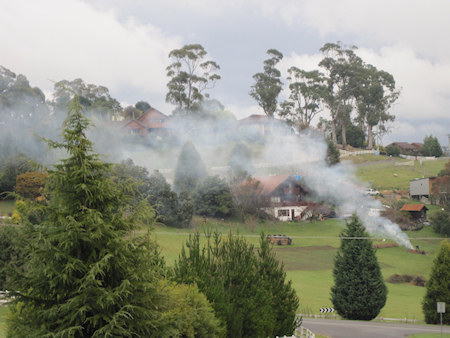
Back yard burning on a block over 2000 square meters.
This burn took place on the July 14 2012.
There had been recent rains and rather than smoke people out and ruin their health I am sure this burner could have loaded the waste on a trailer and taken it to the green waste station 10 minutes away.
This burn took place on the July 14 2012.
There had been recent rains and rather than smoke people out and ruin their health I am sure this burner could have loaded the waste on a trailer and taken it to the green waste station 10 minutes away.
Domestic Smoke Management Program
"Burn Brighter this Winter"
Under the first phase of the Domestic Smoke Management Program, officers from the EPA Division of the Department of Primary Industries, Parks, Water and Environment are collaborating with local councils to reduce domestic wood smoke in two focus areas in Launceston and Hobart.
The Burn Brighter Project is focussed on ways to improve domestic wood heater use in specific areas. Persistent poor air quality from a neighbouring house is not something that has to be tolerated.
The EPA claims smoke from a poorly operated wood heater can be reduced by as much as 80 percent by following a few simple steps - http://epa.tas.gov.au/epa/burn-brighter-this-winter-2013
Tasmanian Women in Agriculture
November 5 2013
"The EPA is interested in discussing air quality issues with the West Tamar Council and the potential for implementing a Burn Brighter this Winter Project in the West Tamar municipality in the future."
Red Hot Tips
Planned Burning on Private Land Field Day
Speakers will include Leanne Sherriff (Macquarie Franklin), Jon Marsden-Smedley, Sandra Whight (State Fire Management Council), Steve Lowe (TFS), John Atkinson (Maitland) and other farmers involved in the pilot project.
The field day will be followed by a BBQ lunch.
WHEN: 8 November 2013, 10.15am - 1pm
WHERE: Campbell Town Hall, 75 High St, Campbell Town
(next door to Campbell Town Fire Station)
"Burn Brighter this Winter"
Under the first phase of the Domestic Smoke Management Program, officers from the EPA Division of the Department of Primary Industries, Parks, Water and Environment are collaborating with local councils to reduce domestic wood smoke in two focus areas in Launceston and Hobart.
The Burn Brighter Project is focussed on ways to improve domestic wood heater use in specific areas. Persistent poor air quality from a neighbouring house is not something that has to be tolerated.
The EPA claims smoke from a poorly operated wood heater can be reduced by as much as 80 percent by following a few simple steps - http://epa.tas.gov.au/epa/burn-brighter-this-winter-2013
Tasmanian Women in Agriculture
November 5 2013
"The EPA is interested in discussing air quality issues with the West Tamar Council and the potential for implementing a Burn Brighter this Winter Project in the West Tamar municipality in the future."
Red Hot Tips
Planned Burning on Private Land Field Day
Speakers will include Leanne Sherriff (Macquarie Franklin), Jon Marsden-Smedley, Sandra Whight (State Fire Management Council), Steve Lowe (TFS), John Atkinson (Maitland) and other farmers involved in the pilot project.
The field day will be followed by a BBQ lunch.
WHEN: 8 November 2013, 10.15am - 1pm
WHERE: Campbell Town Hall, 75 High St, Campbell Town
(next door to Campbell Town Fire Station)

Local Government (Councils)
Wood heaters, fire places, back yard burns, and incinerators
Wood heaters, fire places, back yard burns, and incinerators
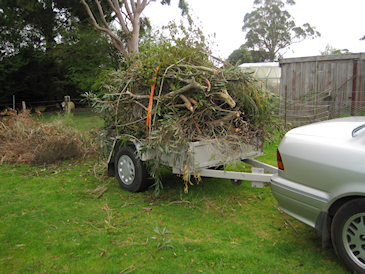
Some people are considerate and take their green waste to the tip for mulching.
This amount of green going to the tip would have saved all that pernicious smoke in the above picture.
This amount of green going to the tip would have saved all that pernicious smoke in the above picture.
"For blocks larger than 2000 square meters with NO OTHER option than burning the waste...."
"Where burning off is absolutely necessary on permitted block sizes, it is important to note that this activity should only be undertaken when it will not interfere unreasonably with another person's enjoyment of the environment...."
West Tamar Council, Residents Newsletter June 2013
"Where burning off is absolutely necessary on permitted block sizes, it is important to note that this activity should only be undertaken when it will not interfere unreasonably with another person's enjoyment of the environment...."
West Tamar Council, Residents Newsletter June 2013
"...State legislation has banned backyard burning on all properties less than 2000 square meters in area."- WTC Beacon June 2013
On the other hand....
Kingsborough Council needs to be congratulated on its approach to outdoor burning on blocks greater than 2000 square metres.
They have enacted a Health and Environmental By-law 3 of 2011
Open air burning:
In accordance with the Health and Environmental Services By-law 3 of 2011, the use of open air fires and/or incinerators is not permitted on any premises:
having an area of less than 2000 square metres; or
within or partly within a residential zone (as defined under the Kingborough Planning Scheme 2000).
unless that fire is for cooking food, heating liquids or for warmth.
The incinerator or open air fire must be positioned:
no less than 5 metres from any boundary of the property; and
no less than 30 metres from any dwelling not on the property; and
clear of any overhanging foliage or other combustible material.
Where the use of an incinerator is permitted, the incinerator must be maintained in good order and fitted with a lid and spark arrester to prevent ash or other particles from escaping.
A person must not burn materials in an open air fire or incinerator that causes a nuisance, is unsafe, or is dangerous to health.
Residents should also be aware that on days of total fire bans, the use of open air fires and incinerators are not permitted for any purpose.
Kingsborough Council needs to be congratulated on its approach to outdoor burning on blocks greater than 2000 square metres.
They have enacted a Health and Environmental By-law 3 of 2011
Open air burning:
In accordance with the Health and Environmental Services By-law 3 of 2011, the use of open air fires and/or incinerators is not permitted on any premises:
having an area of less than 2000 square metres; or
within or partly within a residential zone (as defined under the Kingborough Planning Scheme 2000).
unless that fire is for cooking food, heating liquids or for warmth.
The incinerator or open air fire must be positioned:
no less than 5 metres from any boundary of the property; and
no less than 30 metres from any dwelling not on the property; and
clear of any overhanging foliage or other combustible material.
Where the use of an incinerator is permitted, the incinerator must be maintained in good order and fitted with a lid and spark arrester to prevent ash or other particles from escaping.
A person must not burn materials in an open air fire or incinerator that causes a nuisance, is unsafe, or is dangerous to health.
Residents should also be aware that on days of total fire bans, the use of open air fires and incinerators are not permitted for any purpose.
Go HERE for wood heaters
